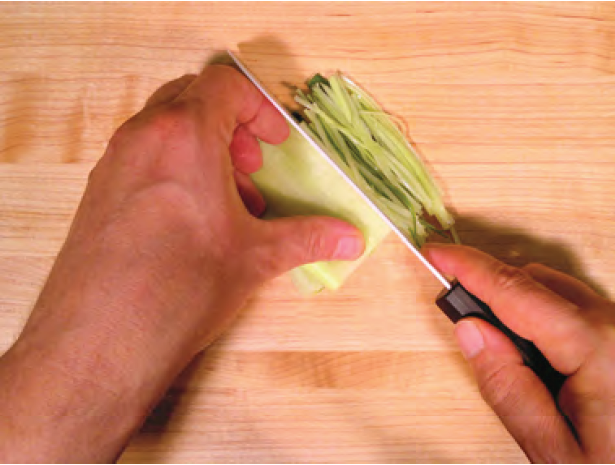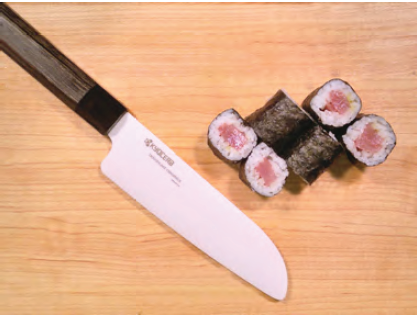KYOCERA presents sushi tips from a professional chef: How to make the Japanese specialty dish at home
Sushi chef Timo Könnecke presents a step-by-step guide on how to prepare sushi at home. With just a few simple steps, fresh ingredients and the new Shin knife series from Kyocera, you can easily make the Japanese specialty dish in your own kitchen.
09 February 2017
Kyoto/Neuss − Sushi is famous for many things. It is said, for example, that the traditional Japanese dish increases your life expectancy if you incorporate it into your regular diet, prevents lung cancer, and even increases your chances of impressing your date. What we can say for absolute certain is that sushi has been one of our favourite foods for a very long time. What’s more, children are increasingly developing a taste for nigiri and maki: A recent study found that 43 per cent of children today eat sushi on a regular basis[1]. The extremely healthy dish comes in many different forms and variations and is increasingly finding its way into the kitchens of British families. The possibilities are endless, and with the right tools from Kyocera, preparing exquisite sushi dishes is not as difficult as some people may think.
Fresh ingredients and the right utensils
While the quality and freshness of the ingredients you use are important, it is also important to use the right tools. Cutting gently and carefully is essential in order to avoid fraying or tearing the fish. Kyocera, the Japanese ceramic knife specialist, offers a wide range of high-quality knives with various designs to meet the highest standards.
Shin series: Quick and easy home-made sushi
Kyocera will present its new Shin knife series, a new innovation for the European market, at the Ambiente trade fair in Frankfurt, Germany. The Shin series features an extremely durable Z212 ceramic blade, which remains sharp for twice as long as other ceramic blades from Kyocera, thanks to a new, innovative production method. The ergonomic handle enables an even more comfortable grip as well as greater control, and the slight bend in the back of the knife allows the blade to slice effortlessly through fish, meat, fruit and vegetables. Furthermore, the knives are incredibly light, extremely flexible and non-corrosive. Since the blade does not transfer any metal ions, it does not leave behind any smell or taste.
This is what makes the Shin series particularly well suited for preparing the Japanese specialty dish in your own kitchen. The knives allow you to cut through fish and vegetables comfortably and quickly, turning them into bite-sized delights.
Preparing the perfect sushi rice
Take approximately 300 grams of rice for two people, and wash it in cold water until the water is clear. The ratio of uncooked rice to water should be 1:1. Cook the rice either in a rice cooker or in a regular pot.
Tip: Rest the rice in the water for 15 to 20 minutes before heating. This will allow you to achieve the perfect, fluffy and sticky texture that is required when rolling and forming the sushi rice.
Bring the water to the boil and then cook the rice at low heat until it has absorbed all of the water. Now it is time to prepare the sushi ‘su’. This is the vinegar mixture that you will marinate the rice in after it has been cooked.
Dissolve 10 g of sea salt and 20 g of white sugar in 35 ml of heated rice vinegar in a small pot. The hot rice is then mixed with the vinegar mixture and left to cool in a bowl – that is as flat as possible – for 30 minutes.
Cutting vegetables made easy
Prepare the vegetables while waiting for the rice to cool. Cut the ingredients into fine slices to use as maki fillings. Traditional Japanese chefs use the ‘katsuramuki’ knife technique to cut long, round vegetables such as cucumbers, radishes and carrots along the circumference to produce a continuous, extremely thin, virtually transparent sheet of vegetable.
Tip: You increase the surface area of the ingredients by cutting finely, which in turn significantly enhances the taste. The Kyocera Shin ceramic knife makes this particularly easy, since it lies comfortably in your hand and can be handled very precisely. Alternatively, you can also use the Kyocera universal slicer.
Rolling sushi the right way: hosomaki
Hosomaki is a sushi dish that is especially well suited for beginners. The small sushi roll, which typically includes only one ingredient, can be filled with cucumber, salmon, tuna or avocado, according to your tastes. The possibilities are endless. Fish is traditionally used as the filling, but vegetarian makis are also very tasty. Place half a sheet of nori seaweed lengthwise along the front edge of the maki mat, and spread a layer of lukewarm sushi rice on it.
Tip: It is easier to form the rice if you slightly moisten your fingers beforehand.
Leave a 1 cm-wide stripe free of rice on the upper side of the nori seaweed. Place the filling horizontally along the centre of the rice. You can also add wasabi to make a spicier maki.
Now roll the sushi using the maki mat. Apply some water to the rice-free edge of the nori to make the roll stick together. Cut the maki into small pieces, and serve with soy sauce and a side of ginger and wasabi.
You can find additional recipes and tips from sushi chef Timo Könnecke in the recipe booklet included with the Sushi Starter Set from Kyocera.
[1] OpenTable survey 2016: Generation Gourmet
[2] Based on internal measurements carried out at Kyocera
For more information about Kyocera:www.kyocera.eu
Editorial Material
- Press Release (pdf) (293.55 KB)
- Kyocera Sushi Recipe Booklet (pdf) (295.32 KB)
- Press Photo (jpg) (60.76 KB)
- Press Photo (jpg) (64.07 KB)
- Press Photo (jpg) (146.79 KB)
- Press Photo (jpg) (169.19 KB)
- Press Photo (jpg) (191.05 KB)
- Press Photo (jpg) (451.83 KB)
- Press Photo (png) (362.05 KB)
- Press Photo (png) (313.70 KB)
- Press Photo (png) (175.52 KB)
Contact for journalists
Daniela Faust
Manager Corporate Communications
E-mail: daniela.faust@kyocera.de
Latest News
- Kyocera Receives Japan’s Environment Minister’s Award for Record 9th Consecutive Year
- Kyocera to Participate in Self-Driving Bus Test Project on JR East BR Lines
- Innovative, durable, and beautiful: Kyocera presents high-quality kitchen tools demonstrating the advantages of its ceramic technology at the BBC Good Food Show in Birmingham from November 29 – December 2, 2018.
- Inamori Foundation Awards the 34th Kyoto Prize to Scientists and Artist in the Fields of "Advanced Technology", "Basic Science", and "Arts and Philosophy"
- KYOCERA reflects on integral philosophy of Founder Dr. Kazuo Inamori to respect the divine and love people
- Kyocera wins CEATEC Award for “Amcenna” IoT Antenna
- KYOCERA celebrates 27 years of sustainability at the core of operations
- Kyocera wins Supplier Award
- Kyocera presents a firework display of innovations at the electronica 2018
- KYOCERA introduces reliable, Waterproof Branch Connector for harsh conditions of automotive electronics
- KYOCERA to Build New Manufacturing Plant in Kanagawa, Japan for Conductive and Insulation Pastes
- KYOCERA steps up expansion strategy with Czech acquisition
- KYOCERA Group to Exhibit Innovative Technologies and Products at CEATEC JAPAN 2018 Tradeshow Oct. 16-19
- KYOCERA introduces a new 12.1” WXGA LCD Module for Off Highway Applications
- KYOCERA at AMB 2018: a world premiere and a number of new products





